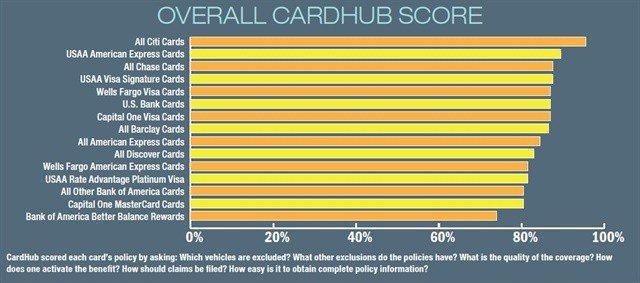- Car Rental Software, Uncategorized
- June 14, 2016
Which Credit Cards Ranked Highest for Rental Insurance Coverage?

The major credit card networks provide some form of rental car insurance coverage to their customers, but types and levels of coverage vary by card, according to the “2016 Credit Card Auto Rental Insurance Report” by CardHub, an online credit card search and compare tool.
CardHub looked at the online car rental policies of all the credit cards currently offered by the 10 largest issuers. It then collected the information needed to answer these six questions: What vehicles are excluded? What other exclusions do the policies have? What is the quality of the coverage? How does one activate the benefit? How should claims be filed? How easy is it to obtain complete policy information?
For the first time this year, CardHub examined the insurance coverage at the card level; its previous studies evaluated coverage at the network level. According to CardHub, it made the change in 2016 after finding inconsistencies among offers on the same network and/or issued by the same credit card company.
After grading the cards, Citi credit cards were found to have the most favorable rental car insurance policies, according to the study. MasterCard took the title for the best network coverage; Visa finished second, followed by American Express and Discover.
Key Findings
Here are some other key findings of the study:
• Almost 40% of cards only cover domestic rentals for up to 15 days.
• There’s a 6% chance you could get penalized for driving on a dirt/gravel road.
• Only Citi and Discover credit cards provide global coverage. Ireland, Jamaica, and Israel are the most common country exclusions among the credit card companies.
• More than 60% of credit cards don’t cover all rim/tire damage.
• Nearly 10% of credit cards will not reimburse you for loss of use, which can cost upward of $100.
CardHub’s study also looked at the coverage that customers can expect from a credit card’s standard rental
insurance policy versus the best policy. For the study, CardHub used American Express’ Rental Collision Policy as the “standard rental insurance policy” and Citi’s Rental Collision Policy as the “best policy.”
For coverage amount, the best policy covers up to $100,000 while a standard policy covers the cost of repairs and the vehicle’s book value or the vehicle’s purchase price (whichever is lower). When it comes to the duration of coverage, most policies cover 30 days; the best policy covers 31 days.
When looking at vehicle exclusions, a standard policy usually excludes vans, trucks, pickups, motorcycles, recreational or off-road vehicles, and certain popular SUVs, antique, exotic, or luxury vehicles. The best policy only excludes off-road vehicles, according to the study. For country exclusions, the standard policy doesn’t cover rentals in Australia, Ireland, Israel, Italy, Jamaica, and New Zealand. The best policy has no country exclusions for renters.
In certain areas of coverage, the “standard policy” and “best policy” don’t vary greatly — if at all. For instance, policies labeled standard to “best” cover costs stemming from damage, theft, or vandalism of rental vehicles. Both standard and “best” types cover towing costs, loss of use, and the personal insurance deductible. In addition, to receive the insurance coverage offered by credit cards, both types only require the customer to decline the rental company’s supplemental coverage.
Source: Auto Rental News


